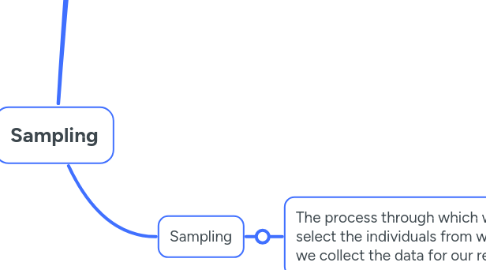
1. Population
1.1. The larger group that will be our target for the research
2. Sample
2.1. The individuals that are narrowed down from the population (in order to make our study practical) and selected for our research
3. Sampling
3.1. The process through which we select the individuals from which we collect the data for our research
3.1.1. Approaches
3.1.1.1. Qualitative Sampling
3.1.1.1.1. Is any research that focuses more on the context, setting, participant's personal opinion, and overall on theoretical data; contrary to the quantitative approach, this one does not usually has measurable data. Instead it is aimed at thought provocation and theoretical inmersion in a field.
3.1.1.2. Quantitative Sampling
3.1.1.2.1. Is any type of sampling that bases on quantifiable data that can be measured.
3.1.2. Process
3.1.2.1. 1. Define the target population (N)
3.1.2.1.1. Identify the group larger from which you will be gathering the data
3.1.2.2. 2. Determine the size of the sample.
3.1.2.2.1. Define a representative sample, using statistical sample measuring formulas, in order to ensure that the sample is large enough to represent the population, but small enought to make the data gathering practical.
3.1.2.3. 3. Make a control check to avoid bias and error
3.1.2.3.1. Be sure that the the sample you select is without bias; there can be a little bias, but you have to make sure that it won't affect the study; still, document any possibility of bias and how it might have affected the study's final resul.
3.1.2.4. 4. Select your sample
3.1.2.4.1. Finally, select the sample considering all the previous points.
